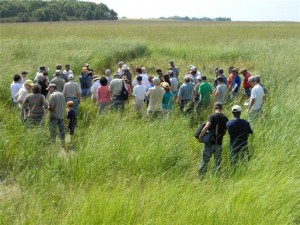Renowned writer William Least Heat Moon once described prairie as a misunderstood and unappreciated ecosystem. He also labeled it “the center of our national identity.”
It is understandably difficult for contemporary Americans to appreciate the aesthetic and biological values of this vital and defining landscape because Least Heat Moon’s so-called “national identity” is nearly extinct.
That unfortunate characterization –nearly extinct- especially applies to tallgrass prairie. Over 99% of the original tallgrass prairie has been plowed and is now cultivated farmland.
America’s tallgrass prairie once extended across the Midwest from what is now the eastern Dakotas to Ohio, and covered most of what we now call the corn belt. It was a vast, prodigious ecosystem that greeted our country’s earliest settlers journeying westward. It dominated what has become the middle of our nation.
Stands of native grass could be impassable, higher than a human, and once mantled the land so densely it appeared as if a beautifully patterned abstract painting had been stretched to the horizon.
Categorizing a landscape as being nearly extinct is a tragic pronouncement, but in the case of tallgrass prairie it is, unfortunately, an accurate one.
Restoring and preserving tallgrass prairie is also bold and ambitious, but at EcoSun Prairie Farm we view this undertaking as essential. Our philosophy is to put prairie to work in order to preserve and protect it.
This underappreciated and misunderstood landscape has mostly been eliminated in order to grow other plants. We are proving that native perennial prairie plants have worthwhile, commercial value, and that growing native prairie plants is better for the natural environment than growing those plants that replaced native prairie, such as corn and soybeans.
We agree with Least Heat Moon that prairie is an important part of our national identity. That’s one reason it is important to restore tallgrass prairie. And that’s what we’re doing at EcoSun farm.
On Friday, August 3rd, starting at 1:00, we are hosting a tour of EcoSun Prairie Farm. You’re invited to visit and learn what we do to restore and expand tallgrass prairie. We will present a variety of speakers, including marketing experts relevant to the products we produce to earn money at our grass farm.
EcoSun farm is located near Colman, South Dakota, about midway between Brookings and Sioux Falls.
To find the farm from Interstate 29, take Exit 114, the Flandreau exit. Travel west on 230th Street for about 3.5 miles (2 miles past the junction with Highway 77) to 469th Avenue. Signs will direct you the remainder of the way. Parking areas will be marked.
We hope to see you at EcoSun farm on Friday.
















